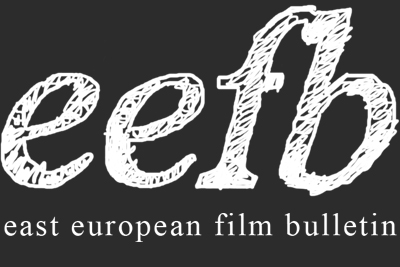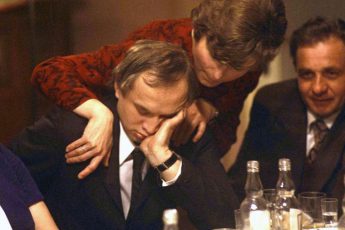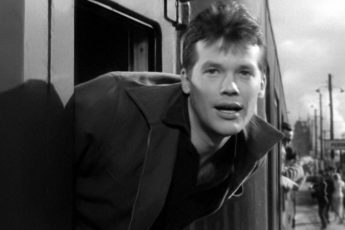Weakness Is Strong
The Collective Body in the Sports Films of Bogdan Dziworski (1970s–1980s)
Vol. 147 (September 2024) by Margarita Kirilkina
Bogdan Dziworski’s films portray bodies in motion in a way that differs from how we are accustomed to seeing them on television or on the big screen. His approach breaks with the tradition of representing the athletic body as a divine form, as a tradition rooted in antiquity had done before him. Positioned between two polar worlds – Western and Eastern – Dziworski, working in a Poland that managed to preserve its cultural identity even under Socialist circumstances, finds his own unique approach to depicting the body of the athlete.
In Dziworski’s films, the body is neither sexualized, as it is in Western cinema, nor reduced to a machine, as it is in representations under authoritarian regimes. The body does not function as a display of sexuality or power, it is not a symbol, but flesh. It can be both strong and weak, beautiful by societal standards, or imperfect. In the Western world, the body has often been a narcissistic object of desire, while in the Soviet tradition, it was a serial, interchangeable entity, merely a machine intended for material production.1 In Dziworski’s films, the athletic body, though belonging to the collective, bears the marks of individuality, placing it somewhere in between these two extremes.
In the summer of 2024, by chance, I watched the Olympic Games on television for the first time. I unexpectedly found myself hypnotized by this parade of beautiful and powerful bodies competing in pursuit of symbolic immortality. That same summer, I also began discovering the films of Bogdan Dziworski from the end of the Socialist era. A graduate of the Cinematography Faculty at the Łódź Film School, the Polish documentary filmmaker was a cinematographer, photographer, and director all at once. I saw the same subject — sports — yet from different angles. One carried forward the tradition of the Greek Olympic Games, grand and celebratory, where the athlete’s body was godlike, worshiped and emulated as the ultimate example of perfection. In contrast, Dziworski’s athletes appeared as sensual as any ordinary mortal. Both images of the athletic body captivated me, but in very different ways: the first invited close-up study, each individual gesture and slowed-down movement showcasing a beauty focused on itself. The second image attracted me with its naturalism, its flaws, and its resemblance to my own body, fragile and vulnerable.
The healthy, strong body of the athlete has long symbolized an ideal of beauty and a model for an entire nation at the height of its prosperity. The male and female athletes in Leni Riefenstahl’s Olympia (1938) are devoid of any pain or strain; they seem light, their gestures imbued with a sense of naturally belonging to humanity. The primary spectator of these bodies is Hitler, who appears periodically in the stands. The bodies on display perform a spectacle of strength and beauty for the regime itself, becoming embodiments of power.
The beautiful body is a sign of authority, an assertion of perfection as an achievement willed into existence by hard work. It is no coincidence that the Olympic Games originated in Ancient Greece at the peak of its prosperity. A spectacular sports victory is a reenactment of military combat, a reminder of one nation’s power over another, a form of intimidating the weak. This spectacle was intended for the gods, with the victor immortalized in a statue, crossing into the symbolic world, his strength becoming undeniable.
Here, a sports event becomes a political ritual, and the body an instrument of authority, representing power through the performance of discipline. In totalitarian states, authority permeates everyday practices, seeking to create a “new human”, with a healthy, beautiful body serving as a screen for its power.2 Soviet Bolsheviks, who came to power in the early 20th century after the October Revolution, were also captivated by the idea of the “new human”. Dreams of absolute transformation within an industrializing society awakened the desire to create an individual who would seamlessly fit into the collective, a fine-tuned machine. Film became a primary medium for conveying these new standards for the human body, showcasing the Olympic winner as the model for heroic bodies across the Socialist bloc to which Poland would belong until the Berlin Wall fell.
Yet, among these politicized bodies, perfected like Greek statues, there had to be space for a body that was sensitive, fragile, alive – a counterbalance to the dominant totalitarian power. Depicting physical vulnerability became a counter-point to the industrial era’s body-machine, during which the body was merely an object of scientific study, a source of statistic data that was to be carefully managed to be able to fulfill its productive role and thus remain desirable.3 In Dziworski’s films from the 1970s and 1980s, shot in Poland, situated between East and West, we see beauty in suffering bodies, bodies that are pushed to exertion and that must overcome their own limits, with the process of this struggle as significant as the outcome.
In Soviet revolutionary films, the mechanism of representing the perfect “immortal” hero was based on a Christian logic of representation, only that religion was, in theory at least, eliminated, elevating man to the status of a god. The main character often had to be killed, sacrificing their individual body in order to be reborn in a collective body. For example, in Battleship Potemkin, this is shown through the character of Vakulinchuk, the instigator of the uprising on the Potemkin, who is killed by officers representing the Tsarist regime. His death becomes the catalyst for the people’s revolt. In this sense, his death is not a manifestation of fragility but a renunciation of individuality, of flesh, in favor of the collective, metaphysical body – the body as a symbol. Vulnerability was taboo, and this remained a tradition in Soviet cinema until the decline of the era. Although Polish cinema was influenced by Soviet power, being part of the Socialist world, and the codes of representation and narrative logic were expected to adhere to the same rules, vulnerability is not eliminated from Bogdan Dziworski’s films. On the contrary, it becomes a form of beauty, an integral part of the transition from one state to another, progressing toward the same collective, a strong body akin to the collective body of the people in Eisenstein’s works.
The athletic body in Dziworski’s documentary films reflects a stance opposed both to the Western cult of the model body and the Eastern body-machine of the working class, trends that predominated in the 1970s when he produced most of his short documentaries. The primary themes of Dziworski’s films are sports and the circus. Clowning and humor represent a popular spectacle, not for the gaze of authority but for the people. His sports films often incorporate circus elements, and his circus films include themes of physical effort. In Classic Biathlon (1978), the Harlequin serves both as a helper, offering skiers water while they are in motion and assisting them when they fall, and as a force that dismantles the pomposity and seriousness of sports competition. Unlike Riefenstahl’s portrayal of Olympians locked in ruthless, life-or-death struggles or the grueling endurance of marathons, Dziworski’s film frames sport as a game where empathy and mutual support are paramount. His camera gives equal weight to moments of vulnerability and displays of strength, emphasizing aspects of humanity lurking underneath the competitiveness.
While power seeks the perfection of a body to embody its spirit, Dziworski’s films show not only the traditionally celebrated moments in sports — the beauty of muscles, and the joy of victory — but also the moments of struggle, stress, and failure. In Ice Hockey (1976), we are watching a hockey match. However, the match itself is constructed from fragments of different games. By showing us small pieces of various matches, Dziworski conveys something holistic about them – something that can only be understood when these fragments come together. The film begins with shots of children practicing hockey. Their movements are clumsy, marked by constant falls – pure effort in its raw form. Suddenly, a sharp transition, aided by sound, shifts the focus to an adult match. Yet visually, we remain in what feels like the same space, creating an impression that we are still within the same moment in time. Here, two perspectives are intertwined: the direct gaze of the camera, as in a televised broadcast, and the subjective view of the hockey player, which the camera adopts. This creates a sense of total immersion in the action, making the viewer feel as though they are one of the athletes. Frame by frame, the film builds tension through intensified moments, grouped by action: attacks, goalkeeping, falls, victories, and the in-between moments that take place in the changing room. These fragments of different matches are pieced together to create an entirely new, phantasmagorical game composed solely of heightened moments.
In the film, the changing room holds as much importance as the hockey field. In this peripheral space, usually hidden from divine sight, sweaty, exhausted hockey players breathe heavily, forming a corporeal mass at its limits. Here, the hero’s body reaches an extreme corporeality absent from the bodies of gods. Collectivity is formed through weakness, which, when united, becomes strength — a concept that aligns with the communist ideal of collective unity, though the fragility of the human body remains visible and valued.
The gestures of one athlete mirror another’s, they become indistinguishable, forming a unity. As biathletes leap for a jump one after another, they merge for the viewer into a single figure, repeating the same motion over and over. The same occurs in The Fencer (1980), where children repeatedly practice the fencer’s gesture, merging individual bodies into a unified whole through ritualized patterns of behavior. The parts that the film is made up of are similarly interwoven. The narrative is constructed through the repetition of frames that capture the same gesture. The next frame is not the continuation of the action but a repetition of the previous one, and the storytelling emerges from segments of identical actions, whether performed by the same character or by different ones. Just as the athletes’ repetitive, equal gestures unite them into teams, the film’s continuity is created through images of repeated actions. As a result, rather than being a confrontation of opposing forces, the sporting event becomes an expression of the collective’s pursuit of beauty and strength.
Situated on the periphery of the Soviet sphere of influence and, at the same time, on the border with the Western world, the athletic body in Dziworski’s films acquires its own meaning without substituting one set of symbols for another. It becomes a reflection of the viewer, not of a god. It is not imposed by any structure of power or economic interest but remains alive – tangible, corporeal, and non-ephemeral. At the same time, the film, constructed in an unconventional way, allows us to observe its structure. In contrast, in the conventional films we are accustomed to, the structure becomes invisible, and we are entirely consumed by the narrative, forgetting about the form. The athletic body, in a sense, strives for perfection, but it is not the perfection of an individual body. It aspires to collective perfection – a body that is not only mine but also my neighbor’s, who suffers as I do while striving for this ideal. It is a body that seeks a healthy kind of perfection, one that retains the right to make an effort and even to err. Through sports, as an activity where the human body reaches the limits of its own effort, Bogdan Dziworski uses the image of the athletic body in his films as a mediator between the Western and Eastern blocs. Within the body, the two oppositions find a compromise, recreating themselves from extremes into a living, vulnerable beauty.
The body becomes a political landscape of the territory. Here, the collective does not reject individuality, and individuality cannot be achieved without the collective. It is the fragile flower of a new world – a world of dreams.
- Groys, Boris (2014). “Alexander Deyneka: The Eternal Return of the Athletic Body”. In: Groys, B. Alexander Deyneka. Moscow: Ad Marginem, pp. 45–63 ↩︎
- Acquarelli, Luca (2015). Esthétisation de la politique et diagrammes de force du pouvoir: la propagande fasciste. Au prisme du figural. Le sens des images entre forme et force. Rennes: Presses Universitaires de Rennes. ↩︎
- Merleau-Ponty, Maurice (1964). L’oeil et l’esprit. éd. Paris: Gallimard; p. 13. ↩︎




Leave a Comment